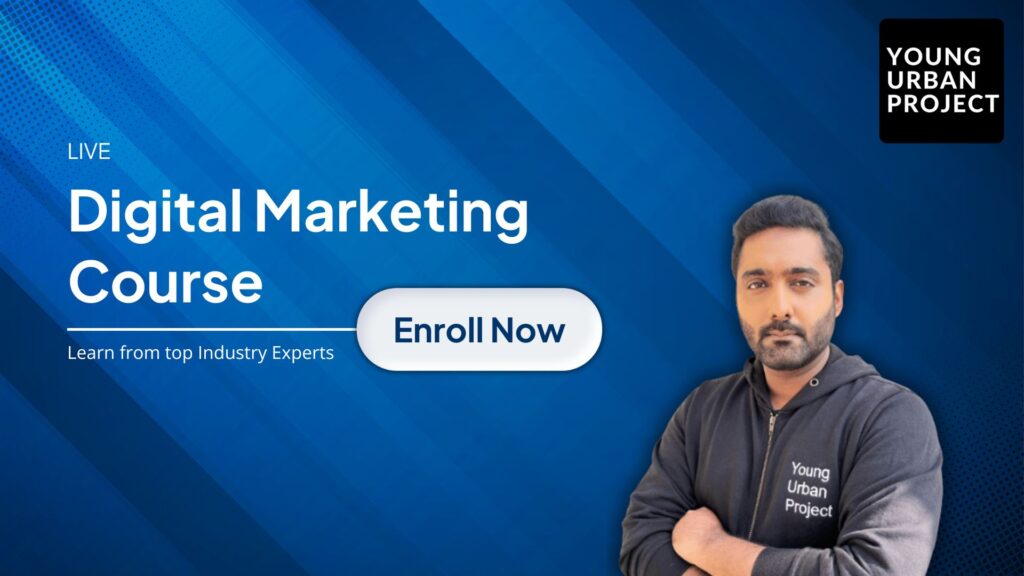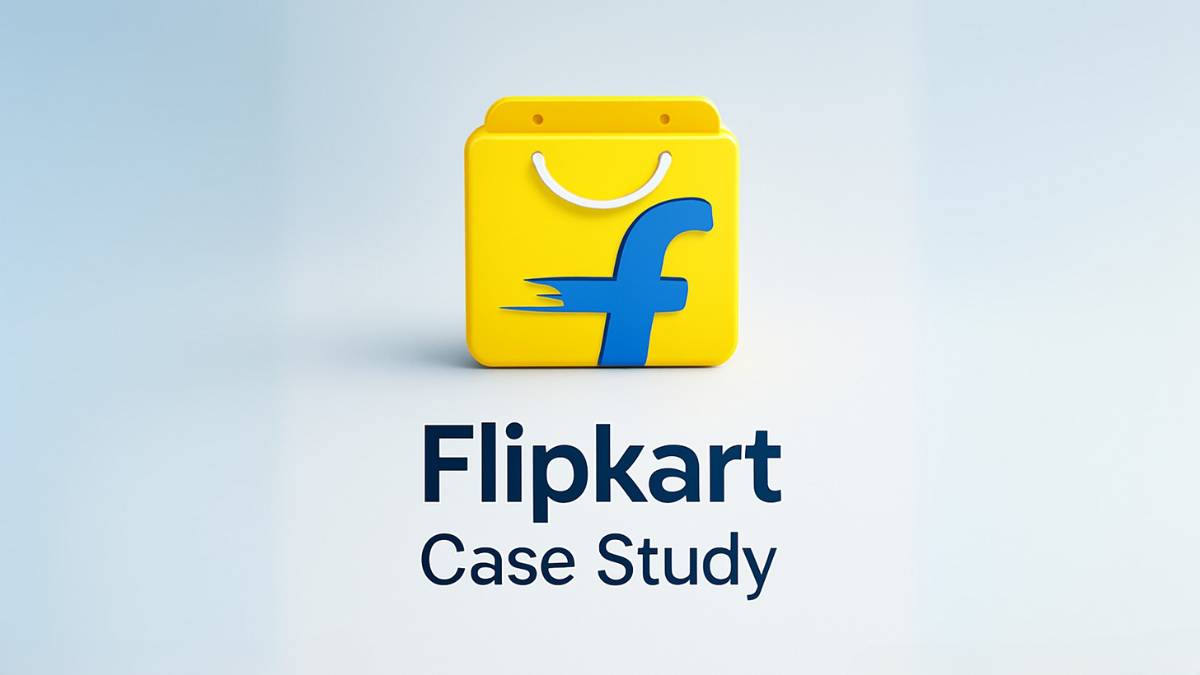You know that moment when you open Flipkart just to “have a look”… and 30 minutes later your cart is overflowing with stuff you swear you didn’t plan to buy? Yep, we’ve all been there.
Table of Contents
Flipkart has that effect. Whether it’s stalking the latest smartphone deals, impulse-buying during Big Billion Days, or getting groceries delivered to your door in a pinch, it’s become second nature for millions of Indians. But here’s the thing: that effortless experience? It’s no accident.
Behind the scenes, Flipkart is running one of the most well-oiled digital marketing machines in India. Every sale, every notification, every “you may also like” suggestion is backed by data, AI, and some very smart strategy.
In this Flipkart case study, we’re diving into exactly how Flipkart became the e-commerce giant it is today, and what marketers and founders can learn from their playbook.
Flipkart: Quick Brand Overview
Flipkart started way back in 2007, in a small apartment in Bangalore. It was founded by two ex-Amazon employees, Sachin and Binny Bansal (not brothers, by the way). Their big idea? Sell books online in India.
It was scrappy at first. Orders were packed by hand, deliveries made by scooter. But they struck a nerve, and not long after, Flipkart began expanding into everything from electronics to fashion to groceries.
The real turning point? In 2018, Walmart came in with a massive $16 billion investment, buying a majority stake. That wasn’t just about the money, it showed the world that Flipkart got India in a way global players didn’t.
Today, Flipkart is a household name, neck-and-neck with Amazon in most major categories, and still holding a strong edge in tier 2 and 3 cities. They’ve built an empire, not just through pricing or product variety, but by deeply understanding how Indians shop.
Flipkart’s Marketing Strategy Breakdown
Now let’s get into the juicy stuff. Flipkart isn’t just throwing ads everywhere, there’s real science and creativity in how they market.
1. Digital Ads & Social Media That Actually Connect
Let’s start with the obvious: Flipkart is everywhere online. Google, Facebook, Insta, YouTube, they’re playing the full digital game. But what’s cool is how they balance hard-selling with fun, pop-culture-driven content.
Their social feeds are full of memes, reels, and collabs with influencers that feel way more like entertainment than advertising. It’s like they’re saying, “Hey, we’re not just here to sell you stuff. We get your humor, your language, your vibe.”
One time during a phone sale, they had influencers do dramatic, funny “unboxing” videos for offers, and it actually worked. The campaign exploded, and people shared it like crazy.
2. Big Billion Days = Big Emotion
If you’ve ever lived through a Big Billion Days campaign, you know it’s not just a sale, it’s an event.
Think countdowns, celebrity-packed TV ads, teaser videos, early-access FOMO. Flipkart doesn’t just launch a sale, they build anticipation weeks in advance. It’s like Diwali came early, with discounts.
And they’re everywhere when it happens, from billboards in small towns to YouTube pre-rolls to those TV ads you can’t skip. They go full desi with it too, regional ads in Tamil, Telugu, and Bengali, depending on where you are. That cultural fit really matters, especially outside metros.
3. Personalization That Feels (Creepy?) Accurate
Ever wondered how Flipkart just “knows” what you were thinking about buying? Yeah, they’re watching.
But not in a scary way. They use AI and your browsing behavior to tweak everything, homepage, search suggestions, email nudges, even those “You forgot this in your cart” pings. It’s smart, and it works.
They’ll show you different ads than your friend, even if you’re in the same city. And those dynamic retargeting ads that follow you around online? Yep, all part of the plan.
4. Loyalty That Doesn’t Feel Like Work
Flipkart Plus is one of those rare loyalty programs that actually feels rewarding. You earn coins, get perks, unlock offers, and you don’t have to pay to join. (Take that, Amazon Prime.)
It’s gamified, it’s fun, and it keeps users coming back for more. Add in things like early access to sales and discount coupons, and it’s no wonder people stick around.
5. Mixing Old School with New School
Despite being an online-first brand, Flipkart hasn’t forgotten the power of traditional media.
During major campaigns, they go all-in on TV, radio, newspapers, and even roadside hoardings. And they really lean into regional languages, especially in states where local trust matters more than digital glitz.
This blend of old-school trust-building with new-school targeting gives them serious reach and recall.
Also Read: Advanced Digital Marketing Course in Panchkula
Business Model of Flipkart: A Strategic Overview
Understanding Flipkart’s business model is like opening up the engine of a high-performance machine, there’s a lot happening under the hood, and each part plays a specific role in driving growth.
1. Core Model: Marketplace & Inventory-Led Hybrid
Flipkart operates on a hybrid model, a mix of marketplace and inventory-led approaches.
In the marketplace model, third-party sellers list their products, and Flipkart facilitates the sale. It earns a commission on each transaction without holding inventory. This helps scale fast with minimal overhead.
But in high-demand or strategic categories like electronics and private labels, Flipkart also uses the inventory-led model, buying in bulk, storing in warehouses, and selling directly. This gives it tighter control over pricing, delivery, and quality, especially during sale periods.
This hybrid model offers flexibility: the scale of a marketplace with the reliability of direct retail.
2. Product & Service Offerings
Flipkart is not just an electronics or fashion site anymore, it’s an ecosystem.
- Categories: Smartphones, laptops, fashion, beauty, home appliances, groceries (via Supermart), and even furniture.
- Private Labels: Brands like MarQ (electronics) and SmartBuy offer better margins and control.
- Logistics: Through its logistics arm Ekart, Flipkart ensures faster deliveries, especially in smaller towns.
- PayLater & Fintech: Flipkart’s PayLater feature allows customers to buy now and pay later, encouraging conversions and reducing cart drop-offs.
By expanding into value-added services, Flipkart isn’t just selling products, it’s building stickiness.
3. Target Audience & Market Segments
Flipkart understands its core shopper deeply, someone who’s price-conscious but not willing to compromise on service.
- Tier 2 and Tier 3 cities are where Flipkart shines. By tailoring offers, language, and delivery options to these markets, Flipkart has built a loyal customer base outside the metro bubble.
- The company also appeals to the value-driven millennial and Gen Z shopper, with EMI offers, deep discounts, and mobile-first design.
This segment-focused approach helps Flipkart balance both scale and reliability.
Also Read: Patanjali Case Study
4. Revenue Streams
Flipkart’s income doesn’t just come from selling products. It has diversified revenue sources:
- Seller commissions from third-party vendors
- Advertising revenue via promoted listings and display ads (yes, sellers pay to be seen first)
- Logistics fees from warehousing and delivery
- Data monetization and fintech partnerships, including PayLater and EMI options
The more sellers, buyers, and categories Flipkart adds, the more its revenue model strengthens through cross-functional synergies.
5. Investors & Funding History
Flipkart’s growth has been powered by some of the biggest names in venture capital.
Early investors included Accel Partners and Tiger Global. But the real turning point was Walmart’s $16 billion acquisition in 2018 (Source), making it one of the largest e-commerce deals globally.
This deal didn’t just inject capital, it gave Flipkart access to global retail know-how and long-term backing, critical for taking on Amazon and future-proofing operations.
6. Partnerships & Ecosystem Play
Flipkart has played smart with acquisitions and spin-offs:
- Myntra & Jabong: Strengthened its presence in fashion and lifestyle.
- PhonePe: Initially a Flipkart product, now a leading UPI platform spun off as a separate entity.
- Strategic collaborations with banks, NBFCs, and brands for exclusive launches and EMI offers.
These partnerships help Flipkart go beyond e-commerce into a full-stack digital commerce ecosystem.
Also Read: Netflix Case Study
Role of Digital Marketing in Flipkart’s Growth
Flipkart isn’t just selling online, it’s marketing online smarter than most. At every stage of the customer journey, there’s a carefully planned nudge, offer, or story pushing you closer to a purchase.
1. Funnel Strategy: Awareness to Conversion
Flipkart’s digital marketing funnel is sharp:
- Top of funnel: Mass awareness via YouTube ads, influencer collaborations, meme marketing, and high-visibility social media posts.
- Middle of funnel: Engaging users with retargeting ads, app install campaigns, product comparisons, and email drips.
- Bottom of funnel: Personalized offers, limited-time deals, abandoned cart nudges, and loyalty-driven discounts.
Each step uses audience segmentation and data triggers to reduce drop-off and boost conversion rates.
Also Read: Uber Case Study
2. Omnichannel Touchpoints & Automation
Flipkart doesn’t leave anything to chance. Whether it’s your email inbox, Instagram feed, or the next video you watch, the brand has built an omnichannel presence that’s hard to ignore.
They use:
- Marketing automation tools to send personalized push notifications and SMS offers based on real-time browsing behavior
- Dynamic creatives in digital ads to show you products you’ve viewed, or even just thought about (seriously, it’s eerie)
- Regional language content to connect emotionally with non-English speaking users
Flipkart’s digital marketing engine is not just big, it’s incredibly efficient and deeply integrated with business outcomes.
And if you’re looking to learn how brands like Flipkart build full-funnel marketing campaigns using tools like Google Ads, Meta platforms, and marketing automation, check out the Young Urban Project’s Digital Marketing Course. It breaks down these strategies into actionable lessons taught by real industry practitioners.

Technological Innovations at Flipkart
Flipkart isn’t just keeping up with technology, it’s often ahead of the curve, quietly embedding innovation into the everyday shopping experience.
- AI & Machine Learning: Flipkart uses ML algorithms for everything from personalized product recommendations to fraud detection. It’s also how the platform adjusts pricing dynamically, predicts demand, and ensures smoother inventory management.
- Augmented Reality (AR): Ever wanted to see how a sofa looks in your living room before buying it online? Flipkart’s “View in Your Room” AR feature allows users to place furniture and appliances virtually, a game-changer for big-ticket purchases.
- Voice Search in Indian Languages: Recognizing the language diversity in India, Flipkart introduced voice-based search in Hindi and other regional languages. This isn’t just smart tech, it’s inclusive UX. For users unfamiliar with English or typing, this opens a gateway to shop comfortably online.
By solving very local problems with global tech, Flipkart is not just scaling, it’s deepening its connection with Indian users.
Also Read: Tata Motors Case Study
CSR & Brand Ethics
As Flipkart scales, it has also taken steps to scale responsibly.
- Flipkart Foundation: Launched to empower underserved communities, this initiative focuses on skill development, education, and supporting entrepreneurship, especially among women and rural youth.
- Sustainability Initiatives: Flipkart has committed to reducing single-use plastic in packaging and using electric vehicles (EVs) in its logistics operations. Ekart is increasingly adopting green delivery solutions to shrink the company’s carbon footprint.
- Rural Inclusion: Through programs that train small sellers in tier 3–4 towns and bring them onto the platform, Flipkart is helping local artisans and MSMEs find a digital marketplace.
These aren’t just checkboxes for ESG, they reinforce Flipkart’s image as a brand that grows with India, not just in India.
Also Read: Amul Case Study
SWOT Analysis of Flipkart
1. Strengths (What Flipkart’s Nailing Right Now)
Brand Power
When someone in India thinks “online shopping,” Flipkart is probably one of the first names that pops into their head. That’s huge. Years of consistent presence, plus all those memorable festive ads, have built serious trust.
Tech + Logistics Muscle
They’ve got a killer backend setup. Personalization, fast delivery (thanks to Ekart), and a user-friendly app that doesn’t feel clunky. Plus, all that AI magic running behind the scenes? It’s quietly making your shopping journey smoother than it looks.
Local Love
Flipkart gets India. Not just the metros, but the heartlands too. Their regional language push, local seller onboarding, and culturally-tuned campaigns give them a strong edge where it really counts.
Also Read: Starbucks Case Study
2. Weaknesses (Where Things Get Tricky)
Thin Margins = Pressure Cooker
Like most big e-comm players, Flipkart still plays the discount game hard. That means slimmer margins, and it’s not always easy to stay profitable, especially with big sale events every few months.
Not Fully in the Green (Yet)
Despite all the growth, Flipkart’s still chasing consistent profitability. With rising costs in logistics, tech, and customer acquisition, the balance sheet isn’t always sunshine and rainbows.
Also Read: Zomato Case Study
3. Opportunities (Where Flipkart Can Level Up)
Go Deeper into Small Towns
Tier 3 and Tier 4 cities are still warming up to online shopping. Flipkart already has a head start there, if they double down on regional languages, local influencers, and fast delivery options, that could unlock serious growth.
D2C Brands, Big Potential
There’s a whole wave of homegrown direct-to-consumer brands coming up in India. Flipkart can partner with or even build its own D2C lines, better margins, exclusive launches, and more control over customer experience.
Services, Subscriptions & Fintech
From PayLater to insurance and EMI offers, Flipkart can lean harder into becoming a full-service digital commerce hub, not just a marketplace. More stickiness, more repeat business.
Also Read: Coca-Cola Case Study
4. Threats (Stuff That Could Cause Trouble)
Cutthroat Competition
Amazon is still a beast, JioMart’s gaining ground, and new players like Meesho are changing the game with social commerce. Staying ahead means constantly innovating, and it’s a sprint, not a jog.
Policy Curveballs
India’s digital and e-commerce regulations are evolving fast. Changes in FDI rules, tax structures, or data privacy laws could mess with operations, especially since Flipkart has global investors in the mix.
Also Read: Uniqlo Case Study
Flipkart vs Competitors: Market Positioning
In India’s e-commerce ring, Flipkart is locked in a constant three-way tussle with Amazon India and Reliance’s JioMart, each with its own edge.
- Amazon India focuses on a premium, service-led experience with Prime. It has deeper global experience but can feel “less local” in its marketing.
- JioMart plays the affordability + grocery card, especially with Reliance Retail’s backend and telecom reach. It’s still growing, but fast.
- Meesho, though not a direct rival in every category, is redefining low-cost, hyper-local shopping via resellers and social commerce.
Also Read: Amazon Case Study: Decoding Its Success
What Flipkart Does Differently
- Emotional Storytelling: Flipkart’s festive ads, kid-centric creatives, and regional content resonate deeply with Indian families.
- Aggressive Loyalty Play: Flipkart Plus and SuperCoins reward systems create stickiness without charging a fee (unlike Amazon Prime).
- Private Labels & AR Tech: These add exclusivity and elevate the shopping experience, especially in furniture and electronics.
Overall, Flipkart strikes a balance between affordability, trust, and innovation, making it the “middle-class India’s favorite”.
Also Read: Myntra Case Study
Conclusion
Flipkart’s journey is more than just an e-commerce success story, it’s a masterclass in understanding the Indian consumer.
From blending high-tech tools with hyper-local insight to using storytelling in digital campaigns, Flipkart shows how marketing and product can work hand-in-hand to build trust, drive adoption, and scale sustainably.
Also Read: McDonald’s Case Study
What Can Marketers and Founders Learn from Flipkart?
- Localize your messaging, it’s not just what you say, it’s how and in which language you say it.
- Data should drive everything, from campaigns to customer service.
- Digital-first doesn’t mean digital-only; blend online and offline for maximum reach.
FAQs: Flipkart Case Study
1. Why does Flipkart focus so much on Tier 2 and Tier 3 cities?
Because that’s where the next wave of online shoppers is coming from. These users want good deals, reliable delivery, and a shopping experience in their own language, and Flipkart is tailoring its platform to match exactly that.
2. What makes Flipkart’s Big Billion Days campaign so effective?
It’s not just about discounts, it’s how the hype is built weeks before. The storytelling, influencer content, app-only deals, and countdowns make it feel like an event, not just a sale.
3. How is Flipkart different from Amazon in India?
Flipkart feels more “desi.” Its campaigns are rooted in Indian culture, it leans heavily on regional languages, and it doesn’t charge for its loyalty program, which makes it more accessible for everyday shoppers.
4. How does Flipkart keep customers coming back?
Through smart use of loyalty points (SuperCoins), frequent flash deals, personalized offers, and fast delivery. But more importantly, it builds trust by solving customer issues quickly and offering easy returns.
5. Is Flipkart using AI just for product suggestions?
Not at all. It uses AI behind the scenes for everything, from detecting fraud to predicting demand in different regions. It even powers dynamic pricing and helps with smarter warehouse management.
6. Can small businesses sell on Flipkart?
Yes, and many do. Flipkart has seller support programs, low entry barriers, and logistics partnerships to help small and regional brands go national, sometimes even global.

